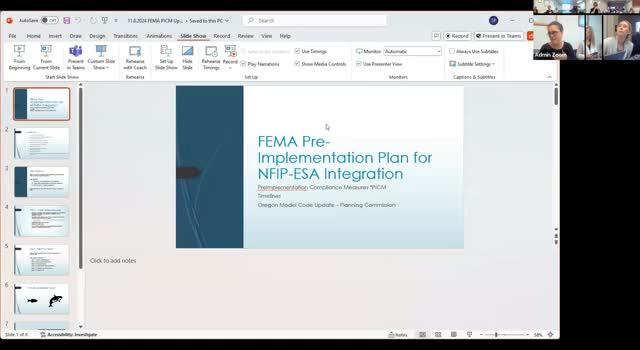FEMA urges Oregon jurisdictions to choose floodplain development compliance plan by December 1
November 13, 2024 | Crook County, Oregon
This article was created by AI summarizing key points discussed. AI makes mistakes, so for full details and context, please refer to the video of the full meeting. Please report any errors so we can fix them. Report an error »

During the Crook County Board of Commissioners Work Session on November 13, 2024, significant discussions centered around the Federal Emergency Management Agency's (FEMA) pre-implementation plan, which is crucial for local jurisdictions in Oregon. The meeting highlighted the urgency for counties to make informal decisions regarding compliance measures by December 1, 2024, to avoid defaulting to a more cumbersome permit-by-permit process.
FEMA's request stems from a biological opinion by NOAA aimed at mitigating habitat loss for 16 fish species and the Southern Resident killer whale. The agency has provided three pre-implementation compliance options for counties to consider, which include a model code update based on Oregon's floodplain regulations, a no-net-loss standard for habitat, and a permit-by-permit habitat assessment approach. The latter option, while initially perceived as daunting, has been clarified to be less intrusive than anticipated, particularly for areas with fewer wetlands.
The commissioners expressed concerns about the implications of these compliance measures on local development, especially in rural areas. The discussions revealed that while the new regulations aim to protect endangered species, they also need to accommodate local land use practices and development needs. The county's unique land use laws and the specific challenges posed by Oregon's regulatory environment were acknowledged, with FEMA representatives indicating a willingness to adapt their approach based on local feedback.
As the December deadline approaches, the commissioners are tasked with determining which compliance model to pursue. They emphasized the importance of building a robust documentation process to ensure that any development aligns with the no-net-loss standard while also considering the practical realities of local land use. The meeting concluded with a commitment to further engage with FEMA for technical assistance and to clarify the requirements necessary for compliance, ensuring that Crook County can effectively navigate these new regulations without stifling development opportunities.
FEMA's request stems from a biological opinion by NOAA aimed at mitigating habitat loss for 16 fish species and the Southern Resident killer whale. The agency has provided three pre-implementation compliance options for counties to consider, which include a model code update based on Oregon's floodplain regulations, a no-net-loss standard for habitat, and a permit-by-permit habitat assessment approach. The latter option, while initially perceived as daunting, has been clarified to be less intrusive than anticipated, particularly for areas with fewer wetlands.
The commissioners expressed concerns about the implications of these compliance measures on local development, especially in rural areas. The discussions revealed that while the new regulations aim to protect endangered species, they also need to accommodate local land use practices and development needs. The county's unique land use laws and the specific challenges posed by Oregon's regulatory environment were acknowledged, with FEMA representatives indicating a willingness to adapt their approach based on local feedback.
As the December deadline approaches, the commissioners are tasked with determining which compliance model to pursue. They emphasized the importance of building a robust documentation process to ensure that any development aligns with the no-net-loss standard while also considering the practical realities of local land use. The meeting concluded with a commitment to further engage with FEMA for technical assistance and to clarify the requirements necessary for compliance, ensuring that Crook County can effectively navigate these new regulations without stifling development opportunities.
View full meeting
This article is based on a recent meeting—watch the full video and explore the complete transcript for deeper insights into the discussion.
View full meeting
